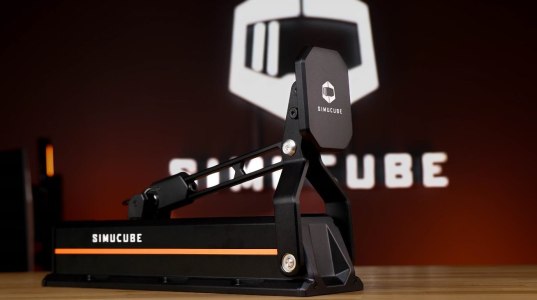Yes, I suspect more people would like more than 1.5" of travel (myself included), even just for road-racing use but, as you say, the cost is a major limiting factor with the D-box systems. I think 3-4" of travel would be great for Road-racing / 6" for Rally & off-road, and flight.
In order to get good suspension effects with tactile, accel & brake-dive, it really uses all of the 1.5" of travel easily and leaves me wanting more and, there are times where the system is basically bottoming out, running out of travel. Like tactile feedback, it's the combined effects that make it tricky to optimize for best results; having more range would surely help.
D-box pitches their system as being the only one that can produce the tactile effects in combination with the motion. They have obviously developed a very advanced system in order to do that and it comes at a premium price. By the specs, the ProSimU system should be more than capable to do it but, is the firmware / software package as capable (?)
As good as the D-box tactile is, there are cases where my SimVibe setup was actually better in some ways, largely because of the shear range of effects possible in SimVibe. There exists much inconsistency in how D-box works with various titles, some have no sub-set of effect-tuning options in the software what-so-ever while others (Pcars2), have many.
Thank you for your great insights! I am convinced D-Box has the better hand at motion. I understand the actuators can change direction so quickly because they are magnetic, it’s effectively a speaker driver, so infinite control of ‘membrane’ movement. All other servo or stepper motor control drivers use worm gears, which can reach very high maximum speeds, but nowhere does it state the speed at which it can change direction. This is also difficult to quantify I guess. This might explains why we don’t see much (any?) servo motor controlled actuators that can do tactile feedback? Thinking about it, if a worm gear has to change direction so fast that it generates something like 80Hz, demonstrated by D-Box in their software test, the worm gear could maybe just not keep up, or because of the slight play in the gearing, just do nothing at all, or it could break the bearings and rattle the housing apart? D-Box has it easy here, the pin just vibrates freely in the housing, can’t go wrong.
BUT for normal use, say kurbs, bumps in the road, throttle/brake application, gear shifting etc. maybe the speed of the servo driven actuators is sufficient? Road feel, I understand could be pushing it..
So if coupled with some tactile transducers, maybe you could get a similar experience from servo actuators as you can from D-Box alone... maybe like 90% the same feeling? I would still get D-Box though if I had unlimited funds, for the plug and play, less cables and less software tuning required.
But since money doesn’t grow on my back, I'd be limited to the 4250i set with 1.5'' travel. This is where my concern comes, maybe I’d be wanting more travel.
So, after reading abcx’s link to the DIY motion on the German forum, I’m totally sold on the idea. As I understand it, you can make those actuators your self for around 400€ per piece. Everything is purchasable from hardware stores and some parts are 3D printed. The servo motors are from AliExpress and are as far as I can see, the same servo motors used by pretty much all manufacturers offering such actuators. They are the stongest ones you can get for this alplication:
http://s.aliexpress.com/Ebqq22A7
Looks pretty similar to the OSW MiGe’s? So they could be very reliable? In the german forum it’s mentioned that they are strong enough that you don’t need to use their full potential.
These actuators are very silent in comparison to stepper motors like the SCN6 and such, watch this video of the motion usage:
Go to 1h37:10, he starts off with only these DIY servo actuators, on a very hard suspension simulation on a bumpy road, then later he adds his other stepper motor actuators that control his rear traction loss, belt tensioner and Frex AirG-Force seat. They are SO much louder! Later on in the video he explaines that he is going to build more of these servo actuators to replace the loud SCN’s.
Another thing that I REALLY like about this DIY project is: the software is open source! That means, sky is the limit, you can make any game work and you can add any effect you want. In the video he says he is a beta tester of the project and he’s tried a lot of different motion systems before, but none so advanced as this one. Take a look at 51:40, he shows how you can change graph’s that correspond to the output of motion derived from telemetry values the software receives from the game. You can make it do whatever you want. You can even add a certian motion to whatever telemetry data you want, look at 57:10.
Later you can add intensity and smoothing to every parameter separately, or a global smoothing or rate, or a maximum travel speed or a minimum travel speed.
Take a look at 1h36:05, you can change the graph real time and see the corresponding output to the motors, even while in game.
I’m sold, I’m going to make 4 of these actuators and start from there, then add another one for ‘surge’, pushing only the seat front/back for braking and gear shifting, then later on a seatbelt tensioner and if I can find space a platform for front and rear traction loss.
If anything breaks, you can buy everything from hardware stores and the plastic parts can just be 3D printed. The software is still very fresh, it was released officially just since a couple of days, so they expect a lot of updates to make it even better. The software also has an output to a soundcard that you can use for tactile feedback, but I hope I can use SimVibe for that.
All in all, this solution seems like the best thing since sliced bread: high performance, high reliability, highly customizable, open source, self repairable, off the shelf parts, and best of all: very affordable!












